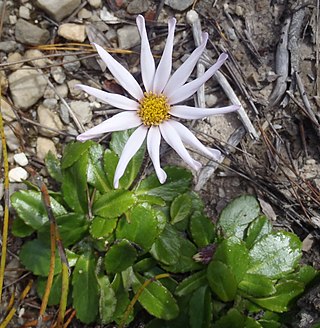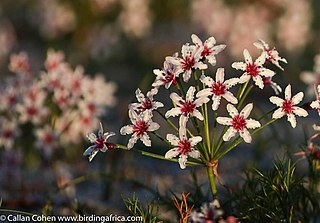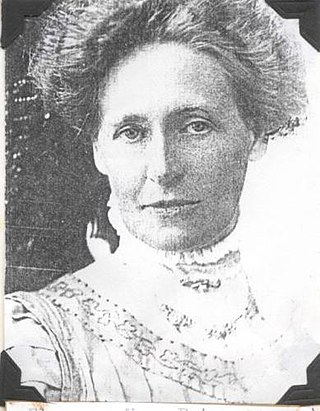Related Research Articles

Adelbert von Chamisso was a German poet,writer and botanist. He was commonly known in French as Adelbert de Chamissode Boncourt, a name referring to the family estate at Boncourt.

William Guybon Atherstone (1814–1898) was a medical practitioner, naturalist and geologist, one of the pioneers of South African geology and a member of the Cape Parliament.

Harry Bolus was a South African botanist, botanical artist, businessman and philanthropist. He advanced botany in South Africa by establishing bursaries, founding the Bolus Herbarium and bequeathing his library and a large part of his fortune to the South African College. Active in scientific circles, he was a Fellow of the Linnean Society, member and president of the South African Philosophical Society, the SA Medal and Grant by the SA Association for the Advancement of Science and an honorary D.Sc. from the University of the Cape of Good Hope.

Peter MacOwan was a British colonial botanist and teacher in South Africa.
Karl Ludwig Philipp Zeyher, was a botanical and insect collector who collected extensively in South Africa. He was the author, with Christian Friedrich Ecklon, of Enumeratio Plantarum Africae Australis (1835-7), a descriptive catalogue of South African plants.
Christian Friedrich Ecklon was a Danish botanical collector and apothecary. Ecklon is especially known for being an avid collector and researcher of plants in South Africa.

Wilhelm Gueinzius was a German naturalist, collector and apothecary.
Karl Heinrich Bergius (1790–1818), also known as Carl Heinrich Bergius, was a Prussian botanist, naturalist, cavalryman and pharmacist from Küstrin. He is notable for his natural history collecting in southern Africa.

Karl Wilhelm Ludwig Pappe was a German-born physician and botanist who lived and worked in South Africa. He was the first person to hold the position of government botanist and the first professor of botany at the South African College. His herbarium became the oldest surviving botanical collection in South Africa.

The Bolus Herbarium was established in 1865 from a donation by Harry Bolus of his extensive herbarium and library to the South African College, which later became the University of Cape Town.

Mairia is a genus of perennial herbaceous plants assigned to the family Asteraceae. All species have leathery, entire or toothed leaves in rosettes, directly from the underground rootstock, and one or few flower heads sit at the top of the stems that carry few bracts. These have a whorl of white to mauve ray florets surrounding yellow disc florets in the centre. In general, flowering only occurs after the vegetation has burned down. The six species currently assigned to Mairia are endemic to the Western Cape and Eastern Cape provinces of South Africa. Some of the species are called fire daisy in English and vuuraster in Afrikaans.

Arabella Elizabeth Roupell was an English flower painter, noted for an anonymous set of flower paintings published in 1849 under the title 'Specimens of the flora of South Africa by a Lady.'

Carl Ferdinand Heinrich von Ludwig aka Baron von Ludwig, the son of a clerk in the ecclesiastical administration, he was a German-born pharmacist, businessman and patron of the natural sciences, noted for having started Cape Town's first botanic garden.

Clemenz Heinrich Wehdemann, a German soldier, artist and naturalist arrived in the Cape Colony in the service of the Dutch East India Company in 1784, and was probably a member of the Württemberg Regiment. Wehdemann was the son of a church minister and enjoyed a sound education.

Gazania krebsiana is a species of flowering plant in family Asteraceae. It is a low-growing herbaceous perennial native to Southern Africa, ranging from Angola, Zambia, and Mozambique to South Africa. It is one of some 19 species of Gazania that are exclusively African and predominantly South African - only Gazania krebsiana subsp. serrulata (DC.) Roessler ventures northwards from the Transvaal into tropical Africa.

Georg Ludwig Engelhard Krebs was a German apothecary and natural history collector who spent his entire career in South Africa.
Pallas & Poleman were South African pharmacists who played a considerable role in plant collecting in the Cape Colony during the years 1810 to 1839, by employing young German pharmacists such as Bergius, Krebs, Drège and Ecklon.

Christian Heinrich Friedrich Hesse was a Lutheran minister, scholar and naturalist.

Leucospermum mundii is an evergreen, upright, rounded and richly branching shrub of ½–1 m (1½–3 ft) high that is assigned to the family Proteaceae. It has greyish, felty hairy, or hairless leaves that are broadly wedge-shaped to very broadly inverted egg-shaped, 5–8½ cm long and 2–6½ cm wide and whorl-shaped flower heads that have shades of pale yellow to crimson, of 2–4 cm (0.8–1.6 in) long and 1–2 cm (0.4–0.8 in) wide that grow in clusters of three to ten. Their long styles that emerge from the head jointly give the impression of a pincushion, with the pins upright. It is called Langeberg pincushion in English. Flowering heads can be found between July and November. It naturally occurs in fynbos in the Western Cape province of South Africa.

Florence Mary Paterson, née Hallack, also known as Mrs. T.V. Paterson, was a South African plant collector. Her specimens are kept in the herbarium of Albany Museum and the Bolus Herbarium of the University of Cape Town. She is honored in the plant name patersoniae and genus name Neopatersonia.
References
- ↑ "Botanical Exploration of Southern Africa" - Gunn & Codd (1981)
- ↑ "Ludwig Krebs, Cape Naturalist to the King of Prussia" - ffoliott & Liversidge (Balkema, 1971)
- ↑ Brummitt, R. K.; C. E. Powell (1992). Authors of Plant Names. Royal Botanic Gardens, Kew. ISBN 1-84246-085-4.